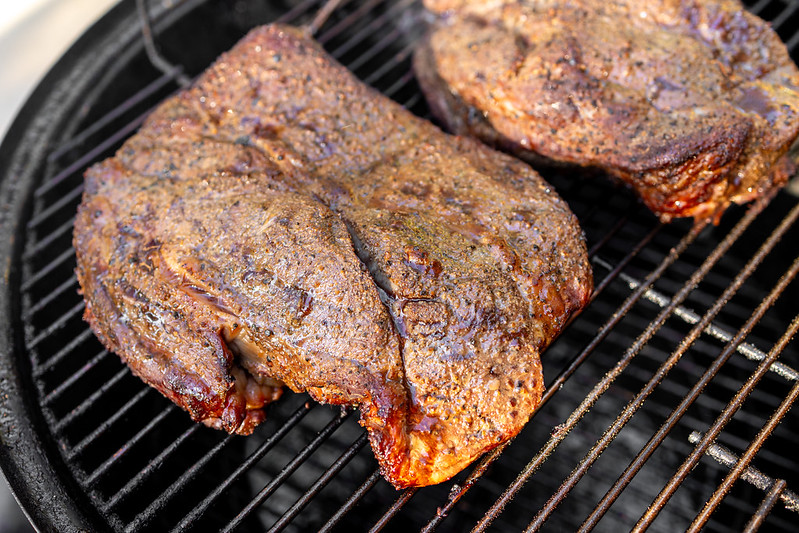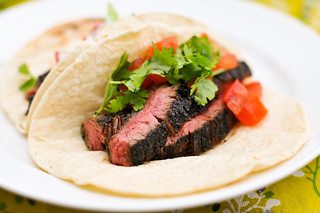Smoked Quesabirria Tacos
If you follow this site intently, you probably have noticed many recipes that make you think, "Hey, isn't Josh late to this game?" This happens because for some odd reason, I instinctually shun the "hot new thing," at least as content for my site, even if I'm enjoying it in real time. The latest example of this are quesabirria tacos, which I like very much and made a mental note to do a recipe for at some point, but I sat on that idea until they seemed to no longer be all the rage. So now that everyone and their grandma seem to have a recipe for this insanely delicious braised meet, I'm releasing my own take, which brings a little barbecue influence into the mix.
This isn't my first time bringing smoking into the fold of traditional Mexican cuisine, I've done both smoked beef and lamb barbacoa recipes in the past. Both of those turned out exceptionally well, so it gave me a pretty clear path to emulate for birria. In both of those recipes, I started by seasoning the meat before sending it to the smoker. For birria, I went kind of light on the spices because I knew the braise was going to be so flavor packed, I didn't want to overdo it.
As the beef smoked at 225°F with a couple chunks of hickory tossed on the coals, there was ample time to assemble the braise, which was a bit of a process. It began with soaking dried chiles in boiling chicken stock to reconstitute them. I went in pretty heavy with the chiles, using six guajillos, two anchos, and a few árbols for an extra touch of heat.
As the chiles steeped, I sautéed onion and whole garlic cloves until browned, then added in a spice mixture of ground sesame seeds, black peppercorns, cumin, and cloves along with oregano and ginger. I cooked all of that until fragarent, then transferred everything, included the soaked chiles, to the jar of a blender.
I also added in a can of fire roasted tomatoes and some vinegar at this point and then blended the entire thing until completely smooth. That sauce got moved into a Dutch oven and combined with the soaking liquid from the chiles, more chicken stock, some bay leaves, and a cinnamon stick. I had this all prepped before the beef was done smoking, so I reheated it a bit when it was time to braise the meat.
The goal of the smoking portion is not to fully cook the meat, but to embed it with enough smokiness that it will be noticeable in the final dish. Meat really only absorbs smoke in the early stages of cooking, so I let the beef cook just until the surface moisture began to go away and the exterior started to form a light bark with the spices well adhered, which took about three hours.
At that point I transferred the beef into the braise. I had two three-pound chunks of beef chuck that I had smoked whole, but I couldn't fit them into the Dutch oven and have them be submerged in the braise without cutting them into smaller pieces first. Once in the braise, I could have either put the Dutch oven back in the smoker or into an oven. There's no real advantage to the smoker at this point except that if you have enough fire to last another three hours, you might as well use it. On this day though, a cold front was passing through with rain, so I wanted to get my smoker put away and I let the beef braise in a 250°F oven.
What I was looking for in this second portion of cooking was for the beef to completely tenderize. It always feels like I'm killing the meat during this process whenever I check it and it's not quite there yet, but patience pays off because it always eventually gets to a point where it's so tender it starts to fall apart if I give a squeeze with tongs or test shred with a fork.
Once done, I removed the beef and shredded it up using my Bear Paws once it was cool enough to do so. I actually made this the day before I was serving it, so I then transferred the braise, which will be referred to as consomé from this point forward, to a large container and stuck it in the fridge along with the beef.
Cooling the consomé was actually a big plus because the next day I was able to separate out the solidified fat from the other liquid. This was important because that fat is what the tortillas get dunked in prior to being griddled, and it's that fat that also makes the tortillas get slightly crisp too. So I put the fat, plus a little consomé in a small pan and reheated it to return it to a liquid state. The rest of the consomé got reheated separately, and I added some beef broth to it to thin it out.
I was cooking for a crowd, so mass taco production was key, and I did that by putting my Baking Steel directly on the grill over a medium fire. Once it was preheated, I could put a bunch of fat coated tortillas on the griddle, add on some cheese and beef, and then cook until the cheese was melted and the tortillas browned and crisped up a bit. I served these with onions and cilantro on the side, but once constructed, it was difficult to get those toppers inside the tacos and I had wished I had put them in during cooking, so I wrote my final recipe to reflect that.
Now, just because I waited forever to do my own quesabirria tacos recipe didn't mean it was any less delicious. In fact, these were some of my favorite quesabirria tacos I've ever had. For starters, the smoke was present, but not overpowering, making this taste pretty unique. Second, my consomé ended up having more heat than most I've had before, and while that wasn't part of my initial plan, it was part of why I personally liked these so much. Beyond that, the tacos were everything you probably already know and love about birria—meat with a very deep and rich flavor, tortillas that also have a bit of that embedded in them, and melted, stringy cheese that helps temper the intensity of flavor in just the right manner. These were so good I worried I may not have any leftovers since I had 20 guests to feed that day, but luckily my entire spread was diverse enough that most folks only had one taco and I was able to freeze two portions to enjoy again at a later date.














